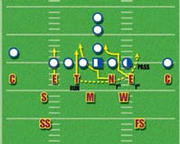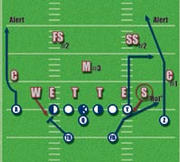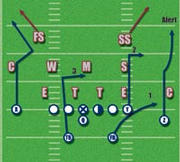West Coast Offense
What is the West Coast offense?
If you've ever wondered what exactly the West Coast offense is, I did a little research. This in no way implies that this is the type of offensive scheme that the Buckeyes use, but it is a widely used offense in college football.
West Coast offense explained
The West Coast offense is a term thrown around a lot. It has come to mean any team that passes more than runs, as each team runs it a tad differently. First the name isn’t even correct. The true West Coach Offense was perfected by Sid Gilliam, then picked up by other great offensive minds like Don Coryell, Norv Turner, Joe Gibbs, Ernie Zampese and others. It’s a longer route type offense which depends on great timing between the Quarterback and Receivers. Bernie Kosar named it the West Coast Offense. The quote was picked up by national media and mis applied to San Francisco.
What is known as the West Coast offense now, was developed in Cincinnati by Bill Walsh and Paul Brown. Walsh himself resisted the West Coast name. This article will try to explain Walsh’s offense.
Walsh needed something for a agile but weak armed Quarterback named Virgil Carter. Carter was the Bengals quarterback in 1970. He could move and throw very accurately but only in short yardage. He didn’t have the arm for the longer patterns. Walsh being the genius he was invented what is known as the West Coast offense. He took it with him to San Francisco when he got the head coach job and the rest is history.
The offense relies on a shorter passing game. The Quarterback can take shorter drops and throws shorter passes. There are also lots of roll out plays if the quarterback in a mobile one. With the shorter passes, the completion percentage goes up. Also it’s harder to sack the quarterback when he takes short drops and releases the ball faster.
The short passing game can overcome the lack of a strong running game. It replaces the running game in one sense. The traditional role of running, is to control the clock and wear down a defense. There are also lots of pass plays for the running backs themselves. Earl Cooper, Roger Craig, Tom Rathmon, Ricky Waters and many other West Coast runners put up great receiving numbers. Craig even turned in the first 1,000 yard rushing and 1,000 yard receiving season, in the same year by a player.
In this offense the short passes are often completed. A 6 yard pass play is as good as a 6 yard run; it still moves the chains, getting first downs. There are a lot of short crossing routes. These are designed for a receiver to catch the ball on the run. If he is in full stride and catches the ball, then makes a tackler miss, he often turns a 10 yard pattern into a 60 yard touchdown catch. Jerry Rice and John Taylor used to do this quite often with the 49ers. A few quarterbacks named, Montana, Young and Farve did ok with this offense as well.
The offense can also overcome a less than great offensive line. The quick drops and quick passes eliminate time for most pass rushers to get a sack. However a good center and guards are a need. Most of the pass rush that DOES get through comes right up the middle. This is the quickest way to the sack.
This offense is so good that pretty much every team uses some of it, or have full versions of the system in place. Some modern coaches who use it are, John Gruden, Mike Holmgren, Mike Shanahan, Andy Reid and others. Often they tweak it a bit to suite their needs. Gruden likes to run the ball a bit more with it. Reid loves to pass way more than run.
I hope this article explained the West Coast Offense a bit. I myself like the real one in the Coryell, Turner camp but there is no argument with the Walsh system’s success.
Sample Play 1
Below are common formations and routes in the West Coast offense. Notice the tight end route to the flat and the half back flare, leaving both short yardage options open to the quarterback. Both receivers run a stop-n-go style route to allow some deep threat.
Sample Play 3 (Defense)
Below is an example of the West Coast defense against the I-formation. The first thing you're going to notice is there are 9 guys in the box. The quarterback must make a good read on this play because the line backers could blitz, or they could stunt and drop back, thus eliminating the quarter backs short underneath routes if its play action.
Sample plays courtesy of American Football Monthly.
Sample Play 2
Again in this play you have the tight end and running backs with the underneath routes, and two wide-outs for the deep threat. In the first play the full back blocks the rush from the left side, where as in this play the running back breaks right behind the line backers, thus leaving 5 guys on the line blocking. This formation is more dangerous against a blitz so the quarterback must be decisive with the ball.


